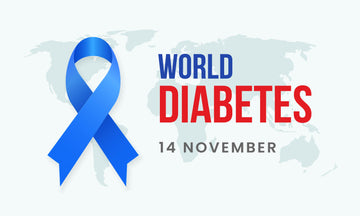November 14th 2023 marks the annual World Diabetes Day established by the international diabetes federation with support from the World Health Organisation. Diabetes is a concerning epidemic that affects nearly 1.9 million Australians with a diagnosis rate of 1 person every 5 minutes. (1)
What is Type 2 Diabetes (T2D)?
A strong causative factor of T2D is genetic predisposition, however environmental factors such as poor diets and sedentary behaviours are largely involved in the pathophysiology of this condition. (2) T2D is characterised by the inability of insulin to clear glucose from the blood stream, and eventually, insufficient insulin secretion from beta cells of the pancreas. (2) Hyperglycaemia is the consequent state resulting from raised blood sugar levels and is associated with a myriad of adverse outcomes. As excess glucose from the blood binds to proteins in the body, complications to the kidneys, retina and cardiovascular system can occur in people living with T2D. (3)
Dietary interventions can be an effective management strategy for T2D. Namely, low carb eating can induce weight loss and improve insulin sensitivity. (4) A dietary pattern that emphasises less carbohydrates is associated with weight loss, which has demonstrated effects on glucose control, cholesterol, and blood pressure. (4) Diets consistent with Mediterranean diet patterns have also shown promise in managing T2D. They are high in fruits, vegetables, legumes, wholegrains, fish and seafood and have resulted in dose reductions of medications used to help manage T2D in some research. (5)
Spread awareness, not stigma
It is important to recognise that T2D is a serious health condition and warrants the same sensitivity in discussion as any disease. Unfortunately, stigmas and discrimination often surround T2D, which may discourage those effected from completing correct self-management including monitoring blood sugar levels, wearing insulin devices, or injecting insulin in public. (6) The importance of November 14th extends beyond spreading awareness and disseminating information on diabetes, it also urges us to replace any negative attitudes, judgments, or beliefs we may associate with T2D with empathy and support. (6)
How can Be Fit Food be used to help manage T2D?
Be Fit Food meals are low in carbohydrates and moderate in protein and healthy fats. The meal plans provided ensure there is a consistent intake of carbohydrates that are spread out evenly throughout the day. This has been shown to be beneficial for managing and treating T2D through helping to stabilise blood sugar levels and increase insulin sensitivity. The Be Fit Food Reset programs are designed to induce mild nutritional ketosis. This is a state in which the body burns stored body fat for energy rather than relying on sugar stores in our body and the sugar intake from our diet. The low carbohydrate and low calorie design of Be Fit Food meals allow this to occur by using up stored sugar in the first few days of the program and limiting dietary carbohydrate intake. Our meals are also made from predominantly low GI carbohydrates, therefore having a stabilising and balancing effect on blood sugar levels. This style of eating can improve blood sugar levels, as demonstrated in Be Fit Food’s published study. Be Fit Food has conducted a study to investigate the influence of the Be Rapid VLCD meal program on weight and glucose markers in people living with T2D. Results demonstrated that one week on the Be Rapid Meal program had a greater impact on weight loss ranging from 0.1-6.2kg in the first week, than the participants self-selected diet. (6) Results also showed lower daily average, daily peak, post-prandial lunch and post-prandial dinner blood glucose levels when following the Be Rapid program.
The findings of this study are supported in the literature. A recent review examined 5 studies which investigated the benefits of a VLCD on remission of T2DM and found several significant improvements in fasting plasma glucose, fasting plasma insulin, HbA1c, weight loss and reliance on medication (7).
References
- Diabetes Australia. (n.d.). Diabetes in Australia. [Online] Available at: https://www.diabetesaustralia.com.au/about-diabetes/diabetes-in-australia/
- Roza, A., Ben-Josef, E., & LeBlanc, M. (2020). Type 2 Diabetes Mellitus (T2DM) [Online]. Available at: https://www.ncbi.nlm.nih.gov/pmc/articles/PMC7503727/#:~:text=Type%202%20Diabetes%20Mellitus%20(T2DM,to%20respond%20appropriately%20to%20insulin.
- Bano, A., & Anjum, S. (2019). Diabetes-related stigma and discrimination: A bibliography of related articles. Cardiovascular Diabetology, 18(1), 76. DOI: 10.1186/s12933-019-0961-7
- Rühli, F. J., Henneberg, M., & Becker, D. (2018). Chronic Diseases and Anthropology: A Bibliography on Multimorbidity. BMJ, 361, k2234. DOI: 10.1136/bmj.k2234
- Centers for Disease Control and Prevention. (n.d.). Experiencing stigma and discrimination can lead to poor mental and physical health. [Online] Available at: https://www.cdc.gov/diabetes/library/features/diabetes_stigma.html#:~:text=Experiencing%20stigma%20and%20discrimination%20can,depression%2C%20anxiety%2C%20and%20embarrassment.
- Save K, Padula M, Murray B, Stephenson M, Costa V, Ballantyne L. The impact of a one week Be-Fit-Food delivered meal program on body composition and blood glucose in Type 2 Diabetes Mellitus patients: Preliminary data. Obesity Research & Clinical Practice. 2019;13(3):313.
- Juray, S., Axen, K. and Trasino, S., 2021. Remission of Type 2 Diabetes with Very Low-Calorie Diets—A Narrative Review. Nutrients, [online] 13(6), p.2086. Available at: <https://www.mdpi.com/2072-6643/13/6/2086> [Accessed 23 September 2021].





